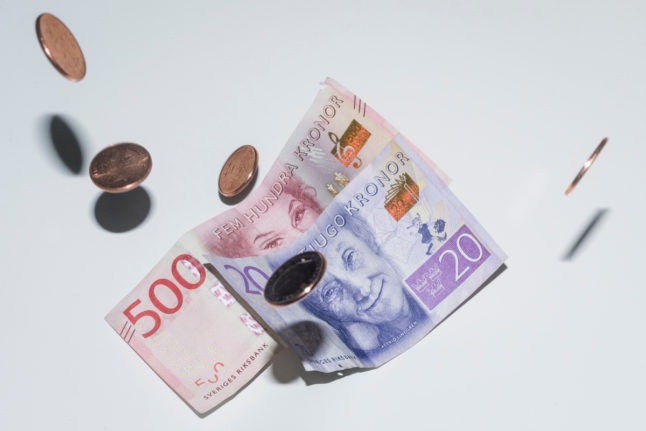What is the government aiming for with this budget?
The government has said that this budget, negotiated with the support of the Sweden Democrats, is part of its long-term plan to navigate Sweden’s difficult economic situation, which has the following aims:
- Fight inflation and support households and welfare
The aim here is “to pursue well-balanced fiscal policy to help drive down inflation while more evenly distributing the burden of high prices”, the government explains on its website.
- Re-institute the “work-first” principle
The work-first principle is essentially the idea that it should be more profitable for an individual to work than to be unemployed.
The government predicts that an additional 40,000 people could become unemployed this year due to the current state of the economy, and plans to address this by providing training and education initiatives to better equip jobseekers, as well as “remedying the labour market’s structural problems” and “reinforcing the motivating factors behind work and self-sufficiency”.
- Structural reforms for stronger growth
Here, the government plans to “shift the focus back to economic development”, by introducing structural reforms to increase productivity and improve long-term growth.
How will proposals in the spring amendment budget affect us living in Sweden?
Much of the budget is aimed at mitigating any adverse effects of the current state of the Swedish economy, with these proposals aiming to keep the status quo and stop things from getting worse.
For example, one of the largest posts in the new budget is 6 billion kronor to Sweden’s regions, which will go towards compensating for the effects of inflation and avoiding dismissals of healthcare staff. This is in addition to 1.5 billion kronor for increased pharmaceutical costs and a 500 million kronor “extra knowledge grant” in additional regional funding for schools.
There are also proposals designed to help anyone who becomes unemployed over the next year, like a proposal to allocate 167 million kronor to creating more places in adult education, as well as extending the temporarily increased housing allowance for economically disadvantaged families with children at a cost of 650 million. The government has also proposed an allocation of 130 million kronor to Swedish municipalities which will be used to fund summer jobs.
There are also investments designed to strengthen law enforcement and improve the safety and security of people living in Sweden, like an allocation of 260 million kronor to the Tax Agency, customs and the Swedish Enforcement Authority which will be used to “crush” criminal finances, as well as 1.38 billion kronor to fund more prison places, 1.035 billion kronor in funding to improve security and baggage handling in airports and 100 million kronor to the Swedish courts.
Some of the proposals are also aimed at improving Swedish defence, like a 300 million kronor allocation to the Swedish Armed Forces and 385 million kronor for strengthening civil defence.
The government has also announced plans to lower tax on both pensions and income, lower fuel tax, and remove tax on the first 300,000 kronor of savings in ISKs – investment saving accounts.
In terms of budget proposals which will affect immigrants in particular, 25 million kronor has been allocated to attracting international talent, 20 million kronor will go towards funding Swedish courses for Ukrainian refugees, and 138 million will cover costs associated with getting Ukrainians on to Sweden’s population register.
How has the opposition reacted?
The Social Democrats’ economic spokesperson, former Finance Minister Mikael Damberg, called it “a tangled mess of proposals” and an “odd budget”, adding that it was “not a budget for the Swedish people”.
He added that the government should not just be focusing on growing the police force, but also on identifying young people who are at risk of sliding into a life of crime, so that social services can step in at an early stage.
The opposition also criticised the government for not doing enough to support Swedish regions, arguing that six billion kronor is not a sufficient investment to solve the healthcare crisis.
The Social Democrats will present their shadow budget in two weeks.
“We think that families with children are in a much worse position due to this crisis. We think that banks have taken out too much in profits, and that there’s a possibility to work with the power of consumers and use the state bank, SBAB,” Damberg said, adding that his party would like to see a bank tax in the new budget.
The government’s decision to scrap tax on ISK savings has also been criticised by two major authorities: the Financial Management Authority (ESV) and the National Institute of Economic Research (NIER, KI in Swedish).
NIER said in a response to the proposal that the tax cut benefits represents a large tax cut to people who already have substantial savings, rather than encouraging people to save more.
“If you’re trying to get more people to save, it’s difficult to understand why the government is setting the limit at 300,000 kronor,” the author of NIER’s response to the proposal, Sebastian Escobar-Jansson, told Swedish news agency TT.
Over half of people with ISK accounts have savings of less than 74,000 kronor.
“More than half of the tax cut benefits those who already have more than 300,000 kronor in an ISK,” ESV added.
In 2024, tax on ISK accounts is 1.086 percent, which is paid whether the account’s investments are making a profit or a loss.



 Please whitelist us to continue reading.
Please whitelist us to continue reading.
Member comments